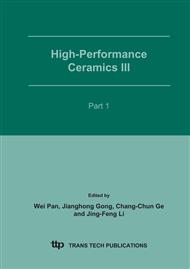p.1605
p.1609
p.1613
p.1619
p.1623
p.1629
p.1631
p.1635
p.1639
Improving Subcritical Crack Growth Resistance for Alumina Glass Dental Composite
Abstract:
Abstract. The improvement of subcritical crack growth (SCG) resistance for alumina glass dental composites was explored in this study. The addition of nitrogen to the glass phases in the composite was found to increase the SCG resistance, where the SCG exponent n increases from 22 for the oxide glass composites to 30 for the composites containing 0.5 mol% nitrogen in the glass phases. The improvement was tentatively attributed to the nitrogen addition, which makes the glass network stronger through forming the non-flexible Si-N bonds and thus inhibits the hydrolysis reactions under the SCG conditions. Analyses demonstrated that the increase of the n value from 22 to 30 offers the potential to greatly extend the lifetime and improve the long-term reliability for the alumina glass dental composites.
Info:
Periodical:
Pages:
1623-1628
Citation:
Online since:
February 2007
Authors:
Price:
Сopyright:
© 2005 Trans Tech Publications Ltd. All Rights Reserved
Share:
Citation:


